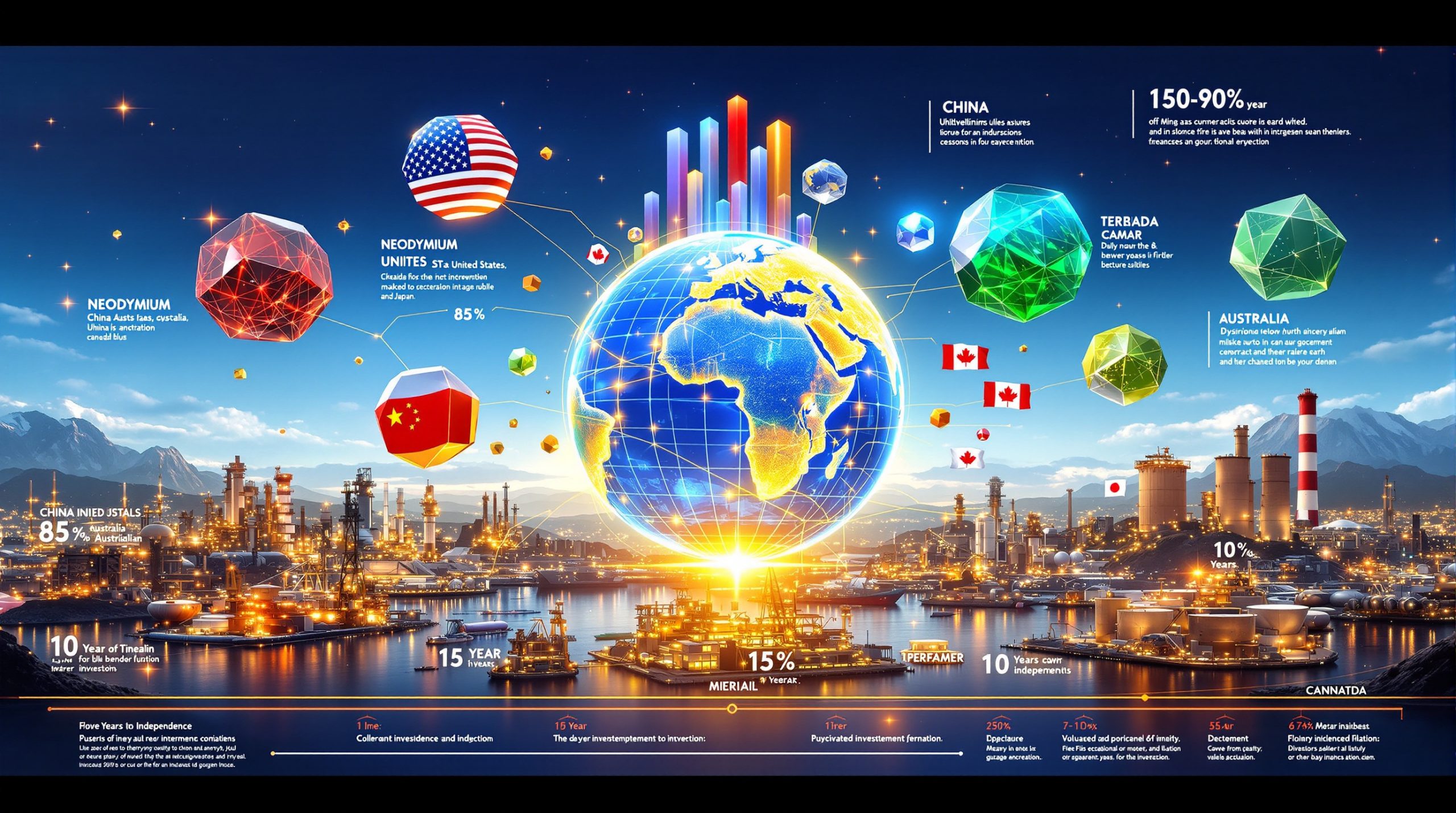Freeport's Benchmark Breakaway: How Copper Pricing Is Changing
The copper industry is witnessing a transformational shift as Freeport-McMoRan, one of the sector's most influential players, signals its intention to abandon the benchmark pricing system it helped establish over decades. This unprecedented move comes amid record-low treatment and refining charges that threaten smelter profitability worldwide, potentially reshaping how copper concentrates are priced globally.
What Is Causing Freeport-McMoRan to Abandon the Copper Benchmark System?
Freeport-McMoRan's potential departure from the copper benchmark pricing system represents a seismic shift in an industry that has relied on standardized pricing mechanisms for decades. This decision comes as treatment and refining charges (TC/RCs) for copper concentrates have plummeted to unprecedented lows in 2025, creating existential challenges for smelters globally.
The 2025 benchmark TC/RC rates reached a record low of $21.25 per metric ton for treatment charges and 2.125 cents per pound for refining charges. These figures represent the lowest benchmark in the industry's history, marking a dramatic decline from the $80/8.0¢ rates seen just a year earlier in 2024.
Recent spot market activity shows even more extreme conditions, with some tender offers displaying negative TC/RCs below -$100 per ton and -10 cents per pound. These negative rates indicate that smelters are effectively paying premiums to secure concentrate supplies, a situation that industry veterans describe as unsustainable.
Javier Targhetta, Freeport's senior vice-president for sales and marketing, has characterized these extreme negative rates as "nonsense" rather than legitimate market benchmarks. With over 35 years of experience in copper markets, Targhetta stated this is the first time in his career he has witnessed sustained negative TC/RC discussions.
The Current Copper Market Crisis
The collapse in treatment and refining charges has created a genuine crisis for copper smelters worldwide. These processing fees typically account for approximately one-third of total smelter revenues, making them crucial for operational viability.
Industry analysis from Wood Mackenzie indicates that smelters require minimum TC/RCs of approximately:
- $35-40 per ton for operational break-even (excluding capital costs)
- $50-60 per ton for full-cycle profitability including capital recovery
With the 2025 benchmark of $21.25/ton, most standalone smelters are operating at financial losses, with independent smelters seeing average EBITDA margins decline from 18% in 2023 to an estimated 5% in 2025.
The situation has become so dire that Atlantic Copper, Freeport's Spanish smelting operation chaired by Targhetta himself, "would not accept a zero tolling fee," according to his public statements. This reflects the fundamental economic reality that smelters cannot process material without adequate compensation for their services.
Freeport's Strategic Shift
Facing this unprecedented market disruption, Freeport appears ready to take extraordinary measures. Rather than continue participating in a benchmark system that threatens smelter economics, the company plans to prioritize processor profitability through alternative pricing mechanisms.
According to Targhetta, if the benchmark continues its downward trajectory in 2026, potentially turning negative, Freeport would likely elect not to follow it. Instead, the company would strike individual supply deals that better protect smelter margins.
This represents a profound shift in strategy for a company that has historically been central to establishing industry benchmarks. For more than three decades, Targhetta personally signed massive supply deals with smelters that routinely provided the global TC/RC benchmark.
The company stepped back from the benchmark-setting process in 2025 after expanding its own smelting capacity, which reduced the volume of concentrates available for sale to third-party buyers. Chilean miner Antofagasta subsequently took the lead in establishing the 2025 benchmark with Jiangxi Copper.
How Does the Copper Benchmark System Actually Work?
Understanding the copper benchmark system requires familiarity with the complex relationship between miners who produce copper concentrates and smelters who process this semi-refined material into usable metal.
Treatment and Refining Charges Explained
Treatment and refining charges (TC/RCs) represent processing fees paid to smelters for converting copper concentrates into refined metal. These charges are deducted from the value of the metal contained in concentrates before payment to miners.
The calculation method works as follows:
- Treatment charges (TCs) are calculated per metric ton of concentrate processed
- Refining charges (RCs) are calculated per pound of copper metal contained in that concentrate
For example, with the 2025 benchmark of $21.25/2.125¢:
- A shipment of 10,000 tons of concentrate containing 25% copper (2,500 tons or 5.5 million pounds of copper)
- Treatment charge: 10,000 tons × $21.25 = $212,500
- Refining charge: 5,500,000 lbs × $0.02125 = $116,875
- Total processing fee: $329,375 deducted from the copper value
These charges typically account for approximately one-third of smelter revenues, with the remainder coming from metal premiums and recovery of valuable by-products such as gold, silver, and sulfuric acid.
The Benchmark Setting Process
The annual benchmark is traditionally established through negotiations between major miners and smelters, typically beginning in the fourth quarter of each year. The resulting agreement serves as a reference price that smaller market participants use throughout the following year.
Historically, the process required consensus between leading producers like Freeport, Codelco, and BHP, and major smelters primarily in Asia. Once established, the benchmark serves as the base price, with adjustments made for:
- Concentrate quality (copper content, impurities)
- Delivery location and logistics
- Payment terms
- Price participation clauses
The historical evolution of the benchmark shows significant volatility:
- 2015: $92/9.2¢ (high point following supply disruptions)
- 2020: $62/6.2¢ (COVID-19 impact)
- 2023: $88/8.8¢
- 2024: $80/8.0¢
- 2025: $21.25/2.125¢ (record low)
This pattern reflects the cyclical nature of the mining industry, but the precipitous drop in 2025 represents something more structural and potentially transformative for the industry.
Why Are Copper Processing Fees at Historic Lows?
Multiple market forces have converged to create unprecedented pressure on treatment and refining charges, creating what analysts describe as a perfect storm in the copper concentrate market.
Supply-Side Disruptions
Major production interruptions at key mines have significantly reduced concentrate availability in global markets:
-
First Quantum's Cobre Panama mine closure: Removed approximately 350,000 metric tons of annual copper production (December 2023 government shutdown). This eliminated approximately 1.4 million tons of copper concentrate from annual global supply.
-
Peruvian Community Actions: Las Bambas mine (MMG Limited) faced 115 days of disruptions in 2024 due to community roadblocks, reducing annual production by approximately 100,000 tons of copper.
-
Anglo American's Peruvian operations faced community blockades reducing output by 40% in Q1 2025.
-
Chilean production declines: Chilean copper production declined 3.2% year-over-year in 2024 due to deteriorating ore grades at aging mines.
Additionally, Indonesia's concentrate export restrictions (implemented 2024) removed approximately 600,000 tons annually from seaborne trade, forcing international smelters to compete more aggressively for remaining supply.
Demand-Side Pressures
While supply has contracted, demand for concentrates has expanded dramatically due to:
-
China's smelting capacity expansion: China added 1.2 million metric tons of new smelting capacity in 2023-2024, including:
- Zijin Mining's 400,000 ton per year smelter in Xinjiang (commissioned 2023)
- CHALCO's 300,000 ton per year expansion in Guangxi (commissioned 2024)
- Multiple smaller expansions totaling 500,000 tons per year
-
Global smelting capacity reached 27.8 million metric tons in 2025, exceeding refined copper demand and leading to capacity utilization rates dropping to approximately 80% in 2025 from historical averages of 90-95%.
-
Increased trader involvement: Market analysts at Fastmarkets noted increased participation from commodity trading houses in concentrate procurement, with traders securing long-term supply agreements that previously would have gone directly to smelters. This additional layer of demand has intensified competition for physical material.
Market Imbalance Metrics
According to Wood Mackenzie's Q3 2025 analysis, the concentrate market faces a structural deficit of approximately 500,000 metric tons in 2025, driven by the combination of mine disruptions and continued smelting expansion. The consultancy projects this deficit could widen to 800,000 tons in 2026 if no new major mines come online.
Forward market indicators show LME copper forward spreads in backwardation of $200-300 per ton, indicating tight nearby supply relative to future availability. Physical premiums in Asia reached $100-120 per ton above LME in September 2025, further demonstrating the intensity of immediate physical demand.
How Will This Decision Impact the Global Copper Industry?
Freeport's departure from the benchmark system represents a seismic shift with far-reaching implications for copper market participants worldwide. The ripple effects will likely transform pricing mechanisms, commercial relationships, and industry structure.
Smelter Economics
The most immediate impact will be on smelter profitability and survival prospects. Integrated operations combining mining and smelting will enjoy significant advantages in this new environment, as they can optimize transfer pricing across the value chain.
Independent smelters (those without mining operations) have already seen average EBITDA margins decline from 18% in 2023 to an estimated 5% in 2025. This contrasts sharply with integrated mining-smelting operations that have maintained margins of 12-15% through upstream profitability.
According to Daniel Fairclough, head of research at Union Bancaire Privée, the breakdown of the benchmark system could accelerate consolidation in the smelting sector, with smaller independent smelters potentially forced to seek equity partnerships with miners or exit the market entirely. He projects 10-15% of global smelting capacity could be idled or permanently closed by 2027 under sustained low TC/RC conditions.
Recent smelter closures already indicate this trend:
- Glencore announced temporary suspensions at its Horne smelter in Quebec (2024) citing unfavorable economics
- Vedanta's Tuticorin smelter in India (capacity 400,000 tons) has been closed since 2018 due to environmental issues
Pricing Transparency Concerns
The abandonment of a universal benchmark raises significant questions about market transparency and price discovery. Robin Bhar, head of metals research at Société Générale, has noted that without a clear benchmark, price discovery will become more challenging, potentially leading to greater volatility in concentrate pricing.
This situation creates opportunities for trading intermediaries but adds risk for smaller market participants with less negotiating power. The industry may need to develop new price reporting mechanisms or indexes to maintain some level of transparency in a more fragmented market.
Supply Chain Realignment
The changing economics will likely drive structural changes in supply chain relationships. Companies with both mining and smelting operations gain significant advantages through vertical integration:
- Average savings of 5-8% in total logistics and transaction costs
- Ability to smooth earnings volatility across the value chain
- Security of processing capacity for their concentrates
- Flexibility in third-party sales based on market conditions
This may accelerate the trend toward integrated operations, with smelters seeking upstream investments in mining assets and miners considering downstream investments in processing capacity. The current market concentration, where the top 5 mining companies control approximately 35% of global copper concentrate production and the top 10 control approximately 55%, gives major miners significant pricing power in this new landscape.
What Is Freeport's Current Position in the Copper Market?
Freeport-McMoRan stands as one of the world's largest publicly traded copper producers, with a substantial global footprint that spans mining, smelting, and refining operations. Understanding the company's position helps explain why its decision carries such weight in the industry.
Freeport's Integrated Operations
Freeport's 2024 production statistics demonstrate its scale in the copper market:
- Total copper production: 4.0 billion pounds (1.8 million metric tons)
- Controlled production capacity: approximately 8% of global mined copper
- Primary operations:
- Grasberg (Indonesia): 1.5 billion pounds
- Morenci (Arizona): 740 million pounds
- Cerro Verde (Peru): 750 million pounds
The company operates an increasingly integrated value chain that includes:
- Atlantic Copper smelter in Spain: Sources concentrates from both Freeport's own mines and third parties
- PT Smelting in Indonesia: Joint venture processing Grasberg concentrates
- Miami smelter in Arizona: Processes North American concentrates
- El Paso refinery in Texas: Final stage processing
This integrated approach allows Freeport to capture value across the entire copper production chain, from mining through refining to metal sales. It also provides strategic flexibility in how concentrates are allocated between internal processing and external sales.
Historical Market Leadership
Freeport has traditionally played a central role in establishing industry benchmarks through its major supply agreements. Targhetta personally negotiated benchmark-setting deals for over three decades, and the company's supply contracts often served as reference points for the wider market.
This leadership position stemmed from Freeport's significant production volumes, global reach, and focus on high-quality concentrate production. The company's strategic decisions have frequently influenced industry direction, making its potential departure from the benchmark system particularly significant.
Strategic Evolution
Freeport's approach has evolved in recent years to emphasize vertical integration and value-added processing. This shift reflects changing market dynamics and a desire to capture more of the value chain within the company's operations.
The company has increased its focus on processing security by expanding smelting capacity, which in turn has reduced its reliance on third-party smelters. This strategic evolution positions Freeport to better weather the current market disruptions compared to pure miners or standalone smelters.
What Alternatives Exist to the Benchmark System?
As the industry potentially moves beyond the traditional benchmark approach, several alternative pricing mechanisms could gain prominence, each with distinct advantages and challenges.
Individual Supply Agreements
Customized bilateral contracts between miners and smelters represent the most likely immediate alternative to benchmark pricing. These agreements can feature:
- Terms tailored to the specific relationship and circumstances
- Potentially more stable pricing structures than benchmark-linked deals
- Floor prices to protect processor margins
- Risk-sharing mechanisms that adjust terms based on market conditions
This approach prioritizes relationship stability over pure price competition, potentially creating more sustainable economic arrangements for both parties. However, it also reduces market transparency and may disadvantage smaller market participants with less negotiating leverage.
Spot Market Expansion
An increased reliance on spot transactions could provide more responsive pricing that better reflects immediate market conditions. This approach:
- Offers greater flexibility to respond to changing supply-demand dynamics
- May better reflect regional market variations
- Requires sophisticated risk management approaches
- Introduces potential volatility that could complicate operational planning
The spot market already handles a portion of copper concentrate trade, but its role has historically been supplementary to benchmark-linked contracts. A significant shift toward spot pricing would require development of more robust price reporting and risk management tools.
Index-Based Pricing
Reference to published price assessments by trusted market reporting agencies could provide an intermediate solution between rigid benchmarks and opaque bilateral deals. Index-based pricing:
- Provides greater transparency than purely bilateral negotiations
- Allows for regular adjustments based on market movements
- Resembles pricing models successfully employed in other commodity sectors
- Can incorporate different terms for different quality tiers or locations
Iron ore's transition from annual benchmarks to index-based pricing during 2009-2010 offers a potential parallel. That shift, driven by similar supply-demand imbalances, initially led to increased price volatility but eventually resulted in more transparent and efficient market mechanisms, including robust derivative markets for price risk management.
How Might Copper Pricing Evolve in 2026 and Beyond?
The copper market stands at a crossroads, with several potential paths forward as traditional pricing mechanisms come under strain. The evolution will likely be influenced by both immediate market pressures and longer-term strategic considerations.
Potential Market Scenarios
Several distinct scenarios could emerge in the coming years:
-
Complete fragmentation of pricing references, with different mechanisms dominating different regions or market segments
-
Development of new industry benchmarks that better reflect current market realities, potentially including minimum processor margins
-
Regional pricing differentiation becoming more pronounced, with different reference prices for Asian, European, and American markets
-
Greater price premium for secure, long-term supply as processing security becomes a strategic priority
The petroleum industry's transition from OPEC reference pricing to market-based pricing in the 1980s provides an instructive parallel. Multiple regional benchmarks emerged (WTI, Brent, Dubai), alongside increased futures market liquidity and more sophisticated price risk management tools. A similar evolution could occur in copper concentrates.
Structural Market Changes
Beyond pricing mechanisms, the industry structure itself is likely to evolve:
-
Direct mine-to-smelter relationships will gain importance, potentially reducing the role of trading intermediaries
-
Processing security will command a premium, with guaranteed smelting capacity becoming a valuable strategic asset
-
More complex hedging and risk management requirements will emerge as pricing becomes more fragmented
-
New market intermediaries may develop to facilitate price discovery and risk management in a more complex environment
Market concentration dynamics will play a critical role in this evolution. The top 5 mining companies control approximately 35% of global copper concentrate production, and the top 10 control approximately 55%. This concentration gives major miners significant pricing power that will influence how alternatives to the benchmark system develop.
Industry Adaptation Strategies
Market participants throughout the copper ecosystem will need to adapt their strategies:
-
Miners may prioritize processing partnerships or investments in downstream capacity
-
Smelters could seek equity stakes in mining operations to secure feed
-
Traders will likely develop new intermediation models focused on risk management and logistics optimization
-
End users may participate earlier in the supply chain to secure access to refined metal
These adaptations will take time to develop fully, potentially creating a transition period characterized by greater volatility and experimentation with different pricing models.
Frequently Asked Questions: Understanding the Copper Benchmark System
What exactly are treatment and refining charges?
Treatment charges (TCs) are fees paid per ton of concentrate processed, while refining charges (RCs) are calculated per pound of contained metal. Together, these fees compensate smelters for converting raw copper concentrate into refined metal ready for industrial use.
The typical copper concentrate contains approximately 25-30% copper, along with other minerals and elements. The smelter must remove these impurities through complex metallurgical processes, including crushing, roasting, smelting, and electrorefining. TC/RCs cover the costs of these processes plus a profit margin.
Why would TC/RCs ever become negative?
Negative TC/RCs occur when concentrate supply becomes so scarce relative to smelting capacity that processors effectively pay a premium to secure material. This happens when the strategic value of keeping smelters operational exceeds the processing costs.
Smelters face high fixed costs and significant technical challenges if they need to stop and restart operations. Running below capacity or shutting down temporarily can cause damage to furnace linings and other equipment, potentially requiring expensive repairs. In some cases, paying a premium to secure concentrate supply may be economically preferable to idling capacity.
How will this affect copper prices for end users?
While TC/RCs represent the processing margin rather than the underlying metal price, disruption to the benchmark system could introduce additional volatility and potentially higher premiums for refined copper.
End users may face:
- Less transparent price formation
- Potentially higher physical premiums above exchange prices
- Greater regional price differentials
- Increased importance of long-term supply relationships
The impact will vary by region and market segment, with buyers having strong relationships with integrated producers potentially enjoying more price stability than those relying on spot purchases.
Are other miners likely to follow Freeport's approach?
Major miners with significant market influence and integrated operations may adopt similar strategies. Companies like Codelco, BHP, Glencore, and Anglo American have the scale and market position to potentially implement alternative pricing approaches.
However, miners focused purely on concentrate production without downstream processing capacity may face more complex negotiations without the benchmark reference point. Their approach will likely depend on their size, the quality of their concentrate, and their strategic relationships with smelters.
The Future of Copper Concentrate Pricing
Freeport-McMoRan's decision to potentially abandon the copper benchmark system marks a watershed moment for an industry that has relied on standardized pricing references for decades. This shift reflects both immediate market pressures and longer-term strategic considerations about how value is distributed across the copper supply chain.
The fundamental challenge lies in balancing the economics of mining and smelting in a way that ensures the viability of both activities. As processing margins face unprecedented compression, the traditional relationship between these two essential components of the copper value chain is being reconsidered.
Market participants throughout the copper ecosystem will need to adapt to a potentially more fragmented, relationship-driven pricing landscape where securing physical supply takes precedence over adherence to historical pricing conventions. The development of alternative pricing mechanisms, whether through bilateral arrangements, index-based pricing, or entirely new systems, will shape the industry's commercial framework for years to come.
The coming year will reveal whether this represents a temporary adjustment to extraordinary market conditions or a permanent structural change in how one of the world's most important industrial metals is priced and traded. Either way, the copper industry appears to be entering a new era characterized by more complex, nuanced pricing relationships that better reflect the strategic value of securing both mining output and processing capacity.
Readers interested in copper market developments should monitor ongoing negotiations during upcoming industry gatherings, as these discussions will provide critical signals about the future direction of concentrate pricing mechanisms.
Ready to Spot the Next Major Mineral Discovery?
Stay ahead of the market with Discovery Alert's proprietary Discovery IQ model, which instantly notifies investors of significant ASX mineral discoveries, turning complex data into actionable insights. Explore our dedicated discoveries page to understand how major mineral discoveries have historically generated substantial returns for early investors.




